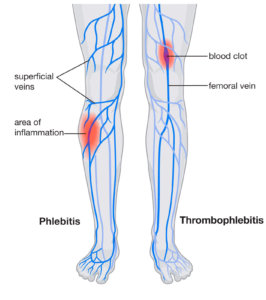What are Phlebitis and Blood Clots?

Superficial phlebitis affects veins on the skin surface. The condition is rarely serious and, with proper care, usually resolves rapidly. Sometimes people with superficial phlebitis also get deep vein thrombophlebitis, so a medical evaluation is necessary.
Deep vein thrombophlebitis affects the larger blood vessels deep in the legs. Large blood clots can form, which may break off and travel to the lungs. This is a serious condition called pulmonary embolism.
Symptoms
The symptoms of phlebitis and blood clot symptoms can affect the leg or arm with the inflamed vein. They may include redness, swelling, tenderness, discoloration on your arm or leg, and a rope-like structure you can feel through your skin. It’s important to note that symptoms do not always arise with this condition
There is usually a slow onset of a tender red area along the superficial veins on the skin. A long, thin red area may be visible as the inflammation follows a superficial vein.
This area may feel hard, warm, and tender. The skin around the vein may be itchy and swollen. The area may begin to throb or burn.
Symptoms may be worse when the leg is lowered, especially when first getting out of bed in the morning. A low-grade fever may occur.
Sometimes phlebitis may occur where a peripheral intravenous line was started. The surrounding area may be sore and tender along the vein.
If an infection is present, symptoms may include redness, fever, pain, swelling, or breakdown of the skin.
Causes and Risk Factors
Superficial phlebitis can be a complication due to a medical or surgical procedure. Injury to a vein increases the risk of forming a blood clot. Sometimes clots occur without an injury. Some risk factors for phlebitis include the following:
- Prolonged inactivity – Staying in bed or sitting for many hours, as in a car or on an airplane, creating stagnant or slow flow of blood from the legs in a dependent position (This pooling of blood in the legs leads to thrombus formation.)
- Sedentary lifestyle – Not getting any exercise
- Obesity
- Smoking cigarettes
- Certain medical conditions, such as cancer or blood disorders, that increase the clotting potential of the blood
- Injury to your arms or legs
- Hormone replacement therapy or birth control pills
- Pregnancy
- Varicose veins
- Phlebitis Symptoms
- Superficial phlebitis
Diagnosis
Exams and Tests
Your health care provider will examine you and ask questions about your symptoms. Although blood tests do not help diagnose phlebitis, they may help identify a blood-clotting disorder. Ultrasound can detect clots or blockage of blood flow, especially in larger, more proximal (upper leg) veins. A small hand-held instrument (probe) is pressed against your skin to help identify blood clots and where the obstruction is. This is a painless, noninvasive test. Occasionally a venogram is needed to identify blood clots in the smaller, more distal veins. This is an invasive procedure that requires injecting x-ray dye or contrast material into a vein on the foot, and then an x-ray is taken of the flow of the dye up the leg.
Treatments
IVC Filter Placement and RemovalIf you would like to schedule an appointment at Preferred Vascular Group to have a consult with a Board-Certified physician or would like to have one of our highly trained care providers reach out to you, please click on a button below:
